This is a fixed-text formatted version of a Jupyter notebook
- Try online
- You can contribute with your own notebooks in this GitHub repository.
- Source files: simulate_3d.ipynb | simulate_3d.py
3D simulation and fitting¶
This tutorial shows how to do a 3D map-based simulation and fit.
For a tutorial on how to do a 3D map analyse of existing data, see the analysis_3d tutorial.
This can be useful to do a performance / sensitivity study, or to evaluate the capabilities of Gammapy or a given analysis method. Note that is is a binned simulation as is e.g. done also in Sherpa for Chandra, not an event sampling and anbinned analysis as is done e.g. in the Fermi ST or ctools.
Imports and versions¶
[1]:
%matplotlib inline
import matplotlib.pyplot as plt
[2]:
import numpy as np
import astropy.units as u
from astropy.coordinates import Angle
from gammapy.irf import load_cta_irfs
from gammapy.maps import WcsGeom, MapAxis, WcsNDMap
from gammapy.modeling.models import PowerLawSpectralModel
from gammapy.modeling.models import GaussianSpatialModel
from gammapy.modeling.models import SkyModel, BackgroundModel
from gammapy.cube import MapDataset, PSFKernel
from gammapy.cube import make_map_exposure_true_energy, make_map_background_irf
from gammapy.modeling import Fit
from gammapy.data import FixedPointingInfo
[3]:
!gammapy info --no-envvar --no-dependencies --no-system
Gammapy package:
version : 0.14
path : /Users/adonath/github/adonath/gammapy/gammapy
Simulate¶
[4]:
irfs = load_cta_irfs(
"$GAMMAPY_DATA/cta-1dc/caldb/data/cta/1dc/bcf/South_z20_50h/irf_file.fits"
)
[5]:
# Define sky model to simulate the data
spatial_model = GaussianSpatialModel(
lon_0="0.2 deg", lat_0="0.1 deg", sigma="0.3 deg", frame="galactic"
)
spectral_model = PowerLawSpectralModel(
index=3, amplitude="1e-11 cm-2 s-1 TeV-1", reference="1 TeV"
)
sky_model = SkyModel(
spatial_model=spatial_model, spectral_model=spectral_model
)
print(sky_model)
SkyModel
Parameters:
name value error unit min max frozen
--------- --------- ----- -------------- ---------- --------- ------
lon_0 2.000e-01 nan deg nan nan False
lat_0 1.000e-01 nan deg -9.000e+01 9.000e+01 False
sigma 3.000e-01 nan deg 0.000e+00 nan False
e 0.000e+00 nan 0.000e+00 1.000e+00 True
phi 0.000e+00 nan deg nan nan True
index 3.000e+00 nan nan nan False
amplitude 1.000e-11 nan cm-2 s-1 TeV-1 nan nan False
reference 1.000e+00 nan TeV nan nan True
[6]:
# Define map geometry
axis = MapAxis.from_edges(
np.logspace(-1.0, 1.0, 10), unit="TeV", name="energy", interp="log"
)
geom = WcsGeom.create(
skydir=(0, 0), binsz=0.02, width=(5, 4), coordsys="GAL", axes=[axis]
)
[7]:
# Define some observation parameters
# We read in the pointing info from one of the 1dc event list files as an example
pointing = FixedPointingInfo.read(
"$GAMMAPY_DATA/cta-1dc/data/baseline/gps/gps_baseline_110380.fits"
)
livetime = 1 * u.hour
offset_max = 2 * u.deg
offset = Angle("2 deg")
[8]:
exposure = make_map_exposure_true_energy(
pointing=pointing.radec, livetime=livetime, aeff=irfs["aeff"], geom=geom
)
exposure.slice_by_idx({"energy": 3}).plot(add_cbar=True);
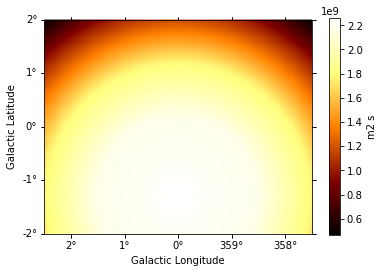
[9]:
background = make_map_background_irf(
pointing=pointing, ontime=livetime, bkg=irfs["bkg"], geom=geom
)
background.slice_by_idx({"energy": 3}).plot(add_cbar=True);
WARNING: Tried to get polar motions for times after IERS data is valid. Defaulting to polar motion from the 50-yr mean for those. This may affect precision at the 10s of arcsec level [astropy.coordinates.builtin_frames.utils]
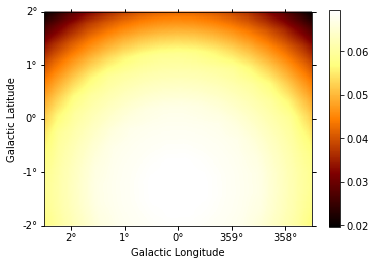
[10]:
psf = irfs["psf"].to_energy_dependent_table_psf(theta=offset)
psf_kernel = PSFKernel.from_table_psf(psf, geom, max_radius=0.3 * u.deg)
psf_kernel.psf_kernel_map.sum_over_axes().plot(stretch="log");
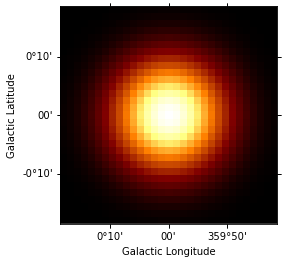
[11]:
energy = axis.edges
edisp = irfs["edisp"].to_energy_dispersion(
offset, e_reco=energy, e_true=energy
)
edisp.plot_matrix();
/Users/adonath/github/adonath/gammapy/gammapy/utils/interpolation.py:159: Warning: Interpolated values reached float32 precision limit
"Interpolated values reached float32 precision limit", Warning
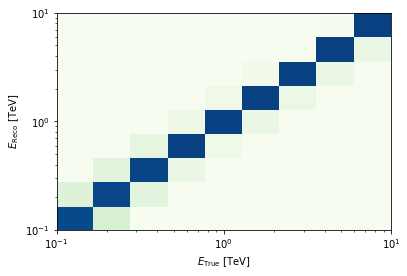
Now we have to compute npred maps, i.e. “predicted counts per pixel” given the model and the observation infos: exposure, background, PSF and EDISP. For this we use the MapDataset object:
[12]:
background_model = BackgroundModel(background)
dataset = MapDataset(
model=sky_model,
exposure=exposure,
background_model=background_model,
psf=psf_kernel,
edisp=edisp,
)
[13]:
npred = dataset.npred()
[14]:
npred.sum_over_axes().plot(add_cbar=True);
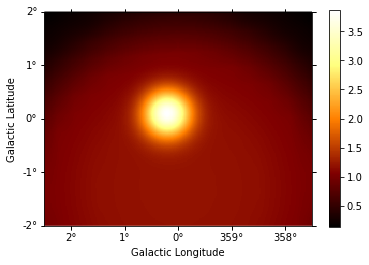
[15]:
# This one line is the core of how to simulate data when
# using binned simulation / analysis: you Poisson fluctuate
# npred to obtain simulated observed counts.
# Compute counts as a Poisson fluctuation
rng = np.random.RandomState(seed=42)
counts = rng.poisson(npred.data)
counts_map = WcsNDMap(geom, counts)
[16]:
counts_map.sum_over_axes().plot();
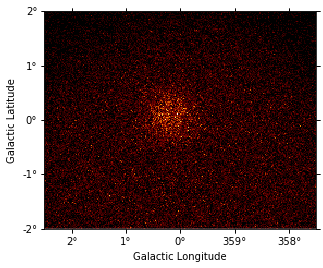
Fit¶
Now let’s analyse the simulated data. Here we just fit it again with the same model we had before, but you could do any analysis you like here, e.g. fit a different model, or do a region-based analysis, …
[17]:
# Define sky model to fit the data
spatial_model = GaussianSpatialModel(
lon_0="0.1 deg", lat_0="0.1 deg", sigma="0.5 deg", frame="galactic"
)
spectral_model = PowerLawSpectralModel(
index=2, amplitude="1e-11 cm-2 s-1 TeV-1", reference="1 TeV"
)
model = SkyModel(spatial_model=spatial_model, spectral_model=spectral_model)
print(model)
SkyModel
Parameters:
name value error unit min max frozen
--------- --------- ----- -------------- ---------- --------- ------
lon_0 1.000e-01 nan deg nan nan False
lat_0 1.000e-01 nan deg -9.000e+01 9.000e+01 False
sigma 5.000e-01 nan deg 0.000e+00 nan False
e 0.000e+00 nan 0.000e+00 1.000e+00 True
phi 0.000e+00 nan deg nan nan True
index 2.000e+00 nan nan nan False
amplitude 1.000e-11 nan cm-2 s-1 TeV-1 nan nan False
reference 1.000e+00 nan TeV nan nan True
[18]:
# We do not want to fit the background in this case, so we will freeze the parameters
background_model.parameters["norm"].value = 1.0
background_model.parameters["norm"].frozen = True
background_model.parameters["tilt"].frozen = True
print(background_model)
BackgroundModel
Parameters:
name value error unit min max frozen
--------- --------- ----- ---- --------- --- ------
norm 1.000e+00 nan 0.000e+00 nan True
tilt 0.000e+00 nan nan nan True
reference 1.000e+00 nan TeV nan nan True
[19]:
dataset = MapDataset(
model=model,
exposure=exposure,
counts=counts_map,
background_model=background_model,
psf=psf_kernel,
edisp=edisp,
)
[20]:
%%time
fit = Fit(dataset)
result = fit.run(optimize_opts={"print_level": 1})
------------------------------------------------------------------
| FCN = 2.34E+05 | Ncalls=214 (214 total) |
| EDM = 4.94E-06 (Goal: 1E-05) | up = 1.0 |
------------------------------------------------------------------
| Valid Min. | Valid Param. | Above EDM | Reached call limit |
------------------------------------------------------------------
| True | True | False | False |
------------------------------------------------------------------
| Hesse failed | Has cov. | Accurate | Pos. def. | Forced |
------------------------------------------------------------------
| False | True | True | True | False |
------------------------------------------------------------------
CPU times: user 8.61 s, sys: 205 ms, total: 8.82 s
Wall time: 8.82 s
True model:
[21]:
print(sky_model)
SkyModel
Parameters:
name value error unit min max frozen
--------- --------- ----- -------------- ---------- --------- ------
lon_0 2.000e-01 nan deg nan nan False
lat_0 1.000e-01 nan deg -9.000e+01 9.000e+01 False
sigma 3.000e-01 nan deg 0.000e+00 nan False
e 0.000e+00 nan 0.000e+00 1.000e+00 True
phi 0.000e+00 nan deg nan nan True
index 3.000e+00 nan nan nan False
amplitude 1.000e-11 nan cm-2 s-1 TeV-1 nan nan False
reference 1.000e+00 nan TeV nan nan True
Best-fit model:
[22]:
print(model)
SkyModel
Parameters:
name value error unit min max frozen
--------- --------- ----- -------------- ---------- --------- ------
lon_0 1.859e-01 nan deg nan nan False
lat_0 8.768e-02 nan deg -9.000e+01 9.000e+01 False
sigma 2.963e-01 nan deg 0.000e+00 nan False
e 0.000e+00 nan 0.000e+00 1.000e+00 True
phi 0.000e+00 nan deg nan nan True
index 3.056e+00 nan nan nan False
amplitude 9.060e-12 nan cm-2 s-1 TeV-1 nan nan False
reference 1.000e+00 nan TeV nan nan True
To get the errors on the model, we can check the covariance table:
[23]:
result.parameters.covariance_to_table()
[23]:
| name | lon_0 | lat_0 | sigma | e | phi | index | amplitude | reference | norm | tilt |
|---|---|---|---|---|---|---|---|---|---|---|
| str9 | float64 | float64 | float64 | float64 | float64 | float64 | float64 | float64 | float64 | float64 |
| lon_0 | 7.777e-05 | 3.542e-07 | -9.078e-08 | 0.000e+00 | 0.000e+00 | -4.063e-06 | 4.966e-17 | 0.000e+00 | 0.000e+00 | 0.000e+00 |
| lat_0 | 3.542e-07 | 7.651e-05 | 1.832e-06 | 0.000e+00 | 0.000e+00 | 3.122e-06 | 4.989e-17 | 0.000e+00 | 0.000e+00 | 0.000e+00 |
| sigma | -9.078e-08 | 1.832e-06 | 3.719e-05 | 0.000e+00 | 0.000e+00 | -5.590e-07 | 7.918e-16 | 0.000e+00 | 0.000e+00 | 0.000e+00 |
| e | 0.000e+00 | 0.000e+00 | 0.000e+00 | 0.000e+00 | 0.000e+00 | 0.000e+00 | 0.000e+00 | 0.000e+00 | 0.000e+00 | 0.000e+00 |
| phi | 0.000e+00 | 0.000e+00 | 0.000e+00 | 0.000e+00 | 0.000e+00 | 0.000e+00 | 0.000e+00 | 0.000e+00 | 0.000e+00 | 0.000e+00 |
| index | -4.063e-06 | 3.122e-06 | -5.590e-07 | 0.000e+00 | 0.000e+00 | 9.348e-04 | -1.197e-14 | 0.000e+00 | 0.000e+00 | 0.000e+00 |
| amplitude | 4.966e-17 | 4.989e-17 | 7.918e-16 | 0.000e+00 | 0.000e+00 | -1.197e-14 | 2.129e-25 | 0.000e+00 | 0.000e+00 | 0.000e+00 |
| reference | 0.000e+00 | 0.000e+00 | 0.000e+00 | 0.000e+00 | 0.000e+00 | 0.000e+00 | 0.000e+00 | 0.000e+00 | 0.000e+00 | 0.000e+00 |
| norm | 0.000e+00 | 0.000e+00 | 0.000e+00 | 0.000e+00 | 0.000e+00 | 0.000e+00 | 0.000e+00 | 0.000e+00 | 0.000e+00 | 0.000e+00 |
| tilt | 0.000e+00 | 0.000e+00 | 0.000e+00 | 0.000e+00 | 0.000e+00 | 0.000e+00 | 0.000e+00 | 0.000e+00 | 0.000e+00 | 0.000e+00 |
| reference | 0.000e+00 | 0.000e+00 | 0.000e+00 | 0.000e+00 | 0.000e+00 | 0.000e+00 | 0.000e+00 | 0.000e+00 | 0.000e+00 | 0.000e+00 |
[24]:
# Or, to see the value of and error on an individual parameter, say index:
print(result.parameters["index"].value, result.parameters.error("index"))
3.055577332085187 0.03057392216430327
[25]:
# TODO: show e.g. how to make a residual image